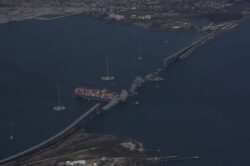Should America Build More Tunnels?
Tunneling has gotten faster, cheaper, and more efficient, and this ought to improve many modes of transport.
The collapse of the Francis Scott Key Bridge after it was struck by a cargo freighter was a disruptive story. As of late March, closing the Port of Baltimore—the country’s 9th busiest—to remove debris was expected to cost $9 million daily in lost revenue and cause a multi-billion hit to the economy. The collapse has made getting around metro Baltimore harder, slowing traffic on one stretch of I-95 by as much as 67%. Given the failure here and with other grade level infrastructure (freight train tracks, highways, etc.), it’s worth asking if tunnels are the better mobility option.

Bridges have long been more economical to build than tunnels, and this remains generally true. But as areas around highways have gotten more built-up, rights of way are harder to carve. And increasingly, cities are trying to reduce the footprint of transportation infrastructure in urban cores, because of the negative externalities it creates, such as noise, pollution and safety hazards. This issue will grow more salient as a number of bridges reach the end of their useful life in coming years.
Tunneling methods and technology have greatly improved the last few decades. Most prominent are tunnel boring machines (TBMs), which carve deep tunnels without impacting surface travel or building foundations. The urban highway tunneling project Americans know best is Boston’s Big Dig, which required tearing up downtown for years and saw its budget expand by a factor of five. TBMs avoid such disruption, thus get projects done faster. Most prominently, a TBM was used to replace the Alaskan Way viaduct in Seattle.
By partially automating construction, TBMs reduce labor costs and worker risk. They’re also able to run constantly, speeding up tunneling time and saving money.
The more conventional “cut-and-cover” tunneling method remains cheaper in absolute terms, and innovations have reduced the length of disruptions. A “top-down” construction method allows for decking that keeps roads open during the tunneling process. Civil engineers in Milan perfected this with the early construction of its metro system.
With mass transit, further savings are possible when tunnels operate automated “light metro” rail lines—because these systems run shorter, more frequent trains, stations can be smaller and cheaper to build.
Of course, bridges have also gotten less obtrusive and more resilient—over-water bridges can be equipped with stronger external structures to absorb the force of a ship strike. And unlike the noisy routes in Chicago and New York’s outer boroughs, modern elevated rail structures are built with concrete, drastically reducing noise and visual impact. Nonetheless, for water crossings in particular, tunnels are more resilient than bridges, and require less land.
Beyond moving people, better tunneling opens up other opportunities to improve infrastructure. Weather-induced power outages make burying utilities tempting, but the cost has been high—imposing as much as a 100% energy cost premium. One firm, Petra, has built a robot that it claims can reduce geological burdens for utility tunneling by boring deeper through rocks.
Even more intriguing, albeit speculative, is the prospect of using tunnels to move light cargo. Magway, a British company, is developing tunnels that it claims can transport packages at 50mph using magnetic levitation technology. In 2020, it announced a proof-of-concept project to deliver packages to airports, but there hasn’t been much news since. If Magway or a competitor is successful, its technology could be a game-changer, mitigating the traffic increases that have come from e-commerce.
It wouldn’t be unlike the pneumatic tubes beneath U.S. cities such as New York, Philadelphia, Boston, and St. Louis, which carried mail from the late 1800s to the 1950s, after which increased mail volume made it less practical.
*
The US’ infrastructure construction cost problems, though, make it difficult to realize the tunneling goal. Rail tunnel projects in Spain, Japan, Italy, and other developed countries are consistently way cheaper, while projects like the #7 subway extension in New York City, using a TBM, carry a billion-dollar per-mile cost. Highway projects have similar cost problems.
So it is worth opening the tunneling process to private companies who may be more inclined to innovate and keep costs low. Some of the aforementioned e-commerce tunnels are a private initiative. The Boring Company completed an initial tunnel in Las Vegas for $47 million, but thus far it doesn’t seem scalable.
If the government is going to continue building infrastructure, though, it ought to consider tunneling, whether for the Francis Scott Key Bridge rebuild or other key projects. Along with the other benefits mentioned above, underground infrastructure is a lot harder to destroy.
Cover image use authorized under the Creative Commons Attribution 2.0 Generic License.
This article featured additional reporting from Market Urbanist content staffer Ethan Finlan.
Catalyst articles by Scott Beyer | Full Biography and Publications
